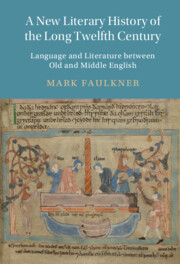36 results
Copyright page
-
- Book:
- A New Literary History of the Long Twelfth Century
- Published online:
- 14 July 2022
- Print publication:
- 28 July 2022, pp iv-iv
-
- Chapter
- Export citation
Contents
-
- Book:
- A New Literary History of the Long Twelfth Century
- Published online:
- 14 July 2022
- Print publication:
- 28 July 2022, pp vii-viii
-
- Chapter
- Export citation
Bibliography
-
- Book:
- A New Literary History of the Long Twelfth Century
- Published online:
- 14 July 2022
- Print publication:
- 28 July 2022, pp 235-277
-
- Chapter
- Export citation
Chapter 2 - Approaching Twelfth-Century English-Language Texts
- from Part I - Preliminaries
-
- Book:
- A New Literary History of the Long Twelfth Century
- Published online:
- 14 July 2022
- Print publication:
- 28 July 2022, pp 32-64
-
- Chapter
- Export citation
Chapter 7 - Conclusion
- from Part II - The Affordances of English
-
- Book:
- A New Literary History of the Long Twelfth Century
- Published online:
- 14 July 2022
- Print publication:
- 28 July 2022, pp 225-234
-
- Chapter
- Export citation
Chapter 4 - English as a Language of Documentary Record
- from Part II - The Affordances of English
-
- Book:
- A New Literary History of the Long Twelfth Century
- Published online:
- 14 July 2022
- Print publication:
- 28 July 2022, pp 102-148
-
- Chapter
- Export citation
Acknowledgements
-
- Book:
- A New Literary History of the Long Twelfth Century
- Published online:
- 14 July 2022
- Print publication:
- 28 July 2022, pp x-xi
-
- Chapter
- Export citation
Chapter 5 - English as a Language for Writing History
- from Part II - The Affordances of English
-
- Book:
- A New Literary History of the Long Twelfth Century
- Published online:
- 14 July 2022
- Print publication:
- 28 July 2022, pp 149-183
-
- Chapter
- Export citation
Figures
-
- Book:
- A New Literary History of the Long Twelfth Century
- Published online:
- 14 July 2022
- Print publication:
- 28 July 2022, pp ix-ix
-
- Chapter
- Export citation
Part I - Preliminaries
-
- Book:
- A New Literary History of the Long Twelfth Century
- Published online:
- 14 July 2022
- Print publication:
- 28 July 2022, pp 1-64
-
- Chapter
- Export citation
Part II - The Affordances of English
-
- Book:
- A New Literary History of the Long Twelfth Century
- Published online:
- 14 July 2022
- Print publication:
- 28 July 2022, pp 65-234
-
- Chapter
- Export citation
Chapter 1 - Introduction
- from Part I - Preliminaries
-
- Book:
- A New Literary History of the Long Twelfth Century
- Published online:
- 14 July 2022
- Print publication:
- 28 July 2022, pp 3-31
-
- Chapter
- Export citation
Chapter 6 - English as a Language for Sermon Writing
- from Part II - The Affordances of English
-
- Book:
- A New Literary History of the Long Twelfth Century
- Published online:
- 14 July 2022
- Print publication:
- 28 July 2022, pp 184-224
-
- Chapter
- Export citation
Dedication
-
- Book:
- A New Literary History of the Long Twelfth Century
- Published online:
- 14 July 2022
- Print publication:
- 28 July 2022, pp v-vi
-
- Chapter
- Export citation
Index
-
- Book:
- A New Literary History of the Long Twelfth Century
- Published online:
- 14 July 2022
- Print publication:
- 28 July 2022, pp 278-290
-
- Chapter
- Export citation
Abbreviations
-
- Book:
- A New Literary History of the Long Twelfth Century
- Published online:
- 14 July 2022
- Print publication:
- 28 July 2022, pp xiii-xviii
-
- Chapter
- Export citation
Conventions Used
-
- Book:
- A New Literary History of the Long Twelfth Century
- Published online:
- 14 July 2022
- Print publication:
- 28 July 2022, pp xii-xii
-
- Chapter
- Export citation
Chapter 3 - English in the Linguistic Ecology of the Long Twelfth Century
- from Part II - The Affordances of English
-
- Book:
- A New Literary History of the Long Twelfth Century
- Published online:
- 14 July 2022
- Print publication:
- 28 July 2022, pp 67-101
-
- Chapter
- Export citation

A New Literary History of the Long Twelfth Century
- Language and Literature between Old and Middle English
-
- Published online:
- 14 July 2022
- Print publication:
- 28 July 2022
Contents
-
- Book:
- The Psalms and Medieval English Literature
- Published by:
- Boydell & Brewer
- Published online:
- 09 May 2017
- Print publication:
- 17 March 2017, pp v-vi
-
- Chapter
- Export citation



